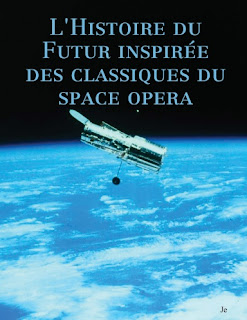By Witold Fraczek, Esri
This article as a
PDF.
The following is not a futuristic scenario. It is not science fiction.
It is a demonstration of the capabilities of GIS to model the results of
an extremely unlikely, yet intellectually fascinating query: What would
happen if the earth stopped spinning? ArcGIS was used to perform
complex raster analysis and volumetric computations and generate maps
that visualize these results.
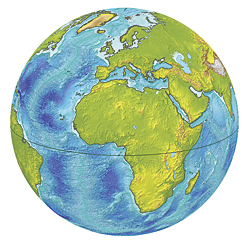 The world as we know it. The obvious demarcation of land and ocean is indicated by the contour of 0 elevation.
The world as we know it. The obvious demarcation of land and ocean is indicated by the contour of 0 elevation.
 The longer, equatorial axis of Earth's ellipsoid is more than 21.4
km (or 1/3 of 1 percent) longer than the polar axis. The flattening of
the ellipsoid shown on this map was intentionally exaggerated.
The longer, equatorial axis of Earth's ellipsoid is more than 21.4
km (or 1/3 of 1 percent) longer than the polar axis. The flattening of
the ellipsoid shown on this map was intentionally exaggerated.
The most significant feature on any map that depicts even a portion
of the earth's ocean is the spatial extent of that water body.
Typically, we do not pay much attention to the delineation of the sea
because it seems so obvious and constant that we do not realize it is a
foundation of geography and the basis for our perception of the physical
world.
The line separating oceans from continents outlining the spatial
extent of both land and water is the most fundamental contour. It is
zero elevation because it signifies the sea level. Why is the sea level
where we currently observe it? What controls the sea level? How stable
are the forces that determine the sea level? This article does not refer
to the climate change and the potential increase of the water level in
the global ocean but rather to the geometry of the globe and the
powerful geophysical energies that determine where oceans lie.
Sea level is—and has always been—in equilibrium with the planet's
gravity, which pulls the water toward the earth's center of mass, and
the outward centrifugal force, which results from the earth's rotation.
After a few billion years of spinning, the earth has taken on the shape
of an ellipsoid (which can be thought of as a flattened sphere).
Consequently, the distance to the earth's center of mass is the longest
around the equator and shortest beyond the polar circles. The current
difference between the average sea level as observed along the equator
and the distance to the earth's center of mass from the sea level at the
poles is about 21.4 kilometers (km).
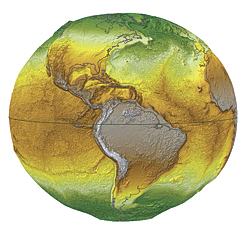 The gravity of the still earth is the strongest at the polar regions
(shown in green). It is intermediate in the middle latitudes and
weakest at the high altitudes of the Andes, close to the equator.
The gravity of the still earth is the strongest at the polar regions
(shown in green). It is intermediate in the middle latitudes and
weakest at the high altitudes of the Andes, close to the equator.
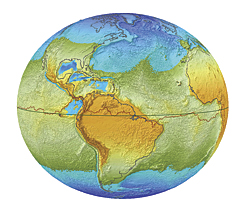
When global rotation stops, the massive
oceanic water migration would cease and sea level would be at different
locations, completely changing world geography.
What would happen if the earth's rotation slowed down and finally
stopped spinning over a period of a few decades? ArcGIS lets us model
the effects of this scenario, performing calculations and estimations
and creating a series of maps showing the effects the absence of
centrifugal force would have on sea level.
If earth ceased rotating about its axis but continued revolving
around the sun and its axis of rotation maintained the same inclination,
the length of a year would remain the same, but a day would last as
long as a year. In this fictitious scenario, the sequential
disappearance of centrifugal force would cause a catastrophic change in
climate and disastrous geologic adjustments (expressed as devastating
earthquakes) to the transforming equipotential gravitational state.
The lack of the centrifugal effect would result in the gravity of the
earth being the only significant force controlling the extent of the
oceans. Prominent celestial bodies such as the moon and sun would also
play a role, but because of their distance from the earth, their impact
on the extent of global oceans would be negligible.
If the earth's gravity alone was responsible for creating a new
geography, the huge bulge of oceanic water—which is now about 8 km high
at the equator—would migrate to where a stationary earth's gravity would
be the strongest. This bulge is attributed to the centrifugal effect of
earth's spinning with a linear speed of 1,667 km/hour at the equator.
The existing equatorial water bulge also inflates the ellipsoidal shape
of the globe itself.
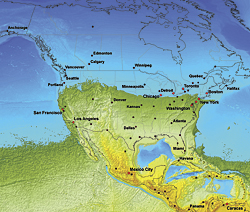 The extent of a hypothetical northern circumpolar ocean over the
territory of North America is shown. The orange color indicates areas
with elevation higher than 3,000 meters above the level of the northern
ocean. Red dots represent some of the biggest cities of the continent.
The extent of a hypothetical northern circumpolar ocean over the
territory of North America is shown. The orange color indicates areas
with elevation higher than 3,000 meters above the level of the northern
ocean. Red dots represent some of the biggest cities of the continent.
The bulge defines the final shape of the globe by establishing the
uniform sea level in gravitational equilibrium, which is used as the
standard reference for describing the shape of the earth. It is the
geometry of this very shape that geodesists were trying to calculate for
more than a century. Their efforts were finalized by the acceptance of
the ellipsoid referred to as World Geodetic System 1984 (WGS84) by the
international community in Washington, D.C., in 1984. The ellipsoid
WGS84 approximates the shape of the earth more accurately than many
other ellipsoids that were previously proposed.
If the earth stood still, the oceans would gradually migrate toward
the poles and cause land in the equatorial region to emerge. This would
eventually result in a huge equatorial megacontinent and two large polar
oceans. The line that delineates the areas that hydrologically
contribute to one or the other ocean would follow the equator if the
earth was a perfect ellipsoid. However, due to the significant relief of
both the continents and the ocean floor, the hypothetical global divide
between the areas that hydrologically contribute to one or another
ocean deviates from the equator significantly. Analogous to the
well-known U.S. Continental Divide, this would be the border separating
two giant hemispherical watersheds of the new circumpolar oceans.
Interestingly, the highest point on this global divide would not be the
highest altitude on the entire globe. The highest elevation of the
global divide in the Colombian Andes would be about 12,280 meters,
whereas the altitudes of the famous equatorial volcanoes of Chimborazo
(Ecuador) and Kilimanjaro (Tanzania) would be 13,615 and 12,786 meters,
respectively. Both volcanoes happen not to be located on the global
divide line. The lowest point on the new global dividing line, with an
elevation of 2,760 meters, would be situated southwest of Kiribati
Island in the western Pacific.
Due to the unique relief of the earth's surface at the beginning of
the slowdown, the most significant changes to the outline of land versus
water would occur at the high latitudes of the northern hemisphere
where the swell ocean would quickly expand over the flat and vast
territories of northern Siberia and northern Canada. At the same time,
changes to the continental outlines at low latitudes would be barely
perceptible because (with a few exceptions) equatorial waters are deep,
and a decrease in water level by a few dozen meters would not cause
large areas of land to emerge. Toward the end of the slowdown period,
when the main geographic features of oceans and land would have already
adjusted to the ellipsoidal shape of the globe and the new distribution
of gravity, relatively small changes would occur. This can be attributed
to the ellipsoidal shape of the globe, which overwhelms the effect of
the diversity of the earth's geographic relief.
Today, all three world oceans are connected. This creates a global
ocean with basically one sea level. As a consequence of rotational
slowdown, the outline of the global ocean would continuously undergo
dramatic changes. Equatorial waters would move toward polar areas,
initially causing a significant reduction in depth while filling the
polar basins that have much less capacity. As regions at high latitude
in the northern hemisphere become submerged, the areal extent of the
northern circumpolar ocean would rapidly expand, covering the vast
lowlands of Siberia and northern portions of North America. The global
ocean would remain one unit until the rotation of the earth decreased to
the speed at which ocean separation would occur. The interaction
between the inertia of huge water bodies and decreasing centrifugal
force would be very complicated. As the consequence of steady slowdown
of earth's rotation, the global ocean would be gradually separated into
two oceans. Obviously, the last connection will be broken at the lowest
point of the global divide line, located southwest of the Kiribati
Islands. Since the current western Pacific Ocean is a plane, land would
emerge quickly because there would be no chance that water would be
exchanged between the two circumpolar oceans after the initial split.
The area of final separation between the two oceans would be the
simultaneous emerging and drying of territory extending for hundreds of
kilometers.
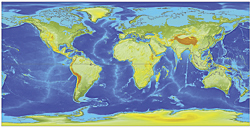 While gravity pulls more water toward the Arctic Ocean, the lowlands
of Siberia and northern Canada would become submerged. The
corresponding movement of water away from the equatorial region combined
with the shallow continental shelf waters southeast of Asia and north
of Australia will cause land to emerge.
While gravity pulls more water toward the Arctic Ocean, the lowlands
of Siberia and northern Canada would become submerged. The
corresponding movement of water away from the equatorial region combined
with the shallow continental shelf waters southeast of Asia and north
of Australia will cause land to emerge.
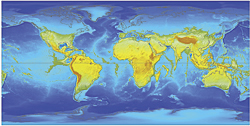 A deepening Arctic Ocean would lead to the further expansion of
water over the northern plains of Asia, Europe, and North America.
Greenland and Antarctica, despite their high elevations, would become
significantly smaller in size. New archipelagos emerge from the southern
seas. The Great American Lakes, the biggest freshwater reservoirs in
the world, dissolve into the ocean.
A deepening Arctic Ocean would lead to the further expansion of
water over the northern plains of Asia, Europe, and North America.
Greenland and Antarctica, despite their high elevations, would become
significantly smaller in size. New archipelagos emerge from the southern
seas. The Great American Lakes, the biggest freshwater reservoirs in
the world, dissolve into the ocean.
The slowdown would continue after the separation of the two oceans
and cause further migration of the ocean water toward the poles.
Surprisingly (despite Antarctica's elevation), the southern polar basin
has a larger capacity than the northern one. Given the fixed volume of
water in both hemispheres, the more capacious basin of the southern pole
would result in an overall lower sea level than the northern ocean.
According to volumetric calculation performed with the ArcGIS 3D Analyst
extension, the difference between the sea level of the two oceans
should be 1,407 meters. However, the data accuracy does not warrant this
level of precision, so the elevation difference between the sea level
of the two oceans used was 1,400 meters.
The series of maps illustrating this article depict the intermittent
stages during this migration of the earth's oceans and changes in land
extents, topographic elevation, and bathymetric depth caused by the
decreasing speed of the earth's rotation. These maps demonstrate the
intermediate stages of transitional geography from a rotating to a
stationary world. They show the effects of the gradual reduction of
centrifugal force from its current level to none, leaving gravity as the
only force controlling the ocean's extent.
The actual slowdown of the earth's rotation has been observed,
measured, calculated, and theoretically explained. As newer
methodologies are developed and more precise instruments are
constructed, the exact rate of the slowdown may vary between some
sources. Reflecting this very gradual slowing, atomic clocks must be
adjusted to solar time by adding a leap second every so often. The first
leap second was added in 1956.
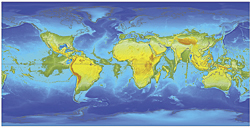 All Antarctica would be under water at this point. The north polar
waters and the water over the vast, recently submerged territories in
Siberia and Canada would be getting deeper. At the same time, equatorial
waters would be getting more shallow.
All Antarctica would be under water at this point. The north polar
waters and the water over the vast, recently submerged territories in
Siberia and Canada would be getting deeper. At the same time, equatorial
waters would be getting more shallow.
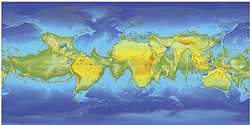 Large land areas near the equator continue growing and join with
each other. By now, nearly all of Canada, Europe, and Russia are covered
by a northern circumpolar ocean.
Large land areas near the equator continue growing and join with
each other. By now, nearly all of Canada, Europe, and Russia are covered
by a northern circumpolar ocean.
Most scientists agree that the solar day (related to the speed of
rotation) is continuously getting longer. This minimal increase of the
day length is due mainly to the oceanic tidal friction. When the
estimated rate of the slowdown was projected back to past geologic eons,
it showed that the length of a day was several hours shorter than
today.
Consequently, during the Devonian period (400 million years ago), the
earth rotated about 40 more times during one revolution around the sun
than it does now. Because the continents have drifted significantly
since that time, it is difficult to make estimates of the land versus
ocean outlines for that era. However, we can be certain that—with a
faster spinning speed in the past—the equatorial bulge of oceanic water
was much larger then than it is today. Similarly, the ellipsoidal
flattening of the earth was also more significant.
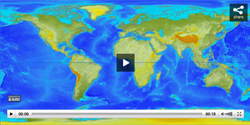 This animation depicts the intermittent stages during this
migration of the earth's oceans and changes in land extents, topographic
elevation, and bathymetric depth caused by the decreasing speed of the
earth's rotation. It shows the effects of the gradual reduction of
centrifugal force from its current level to none, leaving gravity as the
only force controlling the ocean's extent.
This animation depicts the intermittent stages during this
migration of the earth's oceans and changes in land extents, topographic
elevation, and bathymetric depth caused by the decreasing speed of the
earth's rotation. It shows the effects of the gradual reduction of
centrifugal force from its current level to none, leaving gravity as the
only force controlling the ocean's extent.
The influence of the rate of the earth's rotation has a dominant
effect on the geometry of the globe, in terms of the globe's overall
shape as well as the outline of the global ocean. The earth's physical
relief is only a secondary factor controlling the delineation of oceans.
The slowdown of earth's rotation will continue for 4 billion years—as
long as we can imagine. The slowdown infinitesimally—but
steadily—changes the globe's geometry and makes it dynamic. The net
result of these dynamic adjustments is that the earth is slowly becoming
more and more like a sphere. However, it will take billions of years
before the earth stops spinning, and the gravitational equipotential
creates a mean sea level that is a perfect sphere.
About the Author
Witold Fraczek is a longtime employee of Esri who currently works in
the Application Prototype Lab. He received his doctorate in the
application of GIS in forestry from Agricultural University and master's
degrees in hydrology from the University of Warsaw, Poland, and remote
sensing from the University of Wisconsin, Madison.
Source : http://www.esri.com/news/arcuser/0610/nospin.html

